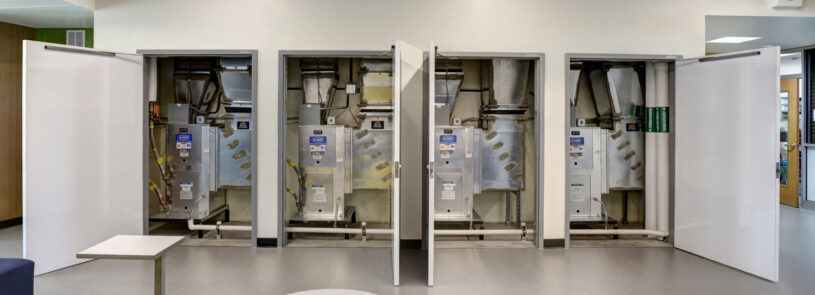Electrification is a critical step toward a ‘cleaner’ building or campus

By Adam McMillen
Many building owners and institutional leaders are looking to implement decarbonization projects for their facility or campus—i.e., reduce and eventually eliminate the use of carbon-based energy for heating and cooling buildings and operating equipment. Such a journey can be daunting at the outset, but the long-term operational and environmental benefits are many.
IMEG’s latest decarbonization executive guide examines the benefits and challenges and provides a practical approach for undertaking such a journey. This includes “electrification”—the gradual introduction of electric equipment and systems in place of their oil- and natural-gas burning counterparts. (Pictured: Heat pumps—an option for electric heating—shown inside closets at a middle school.)
Electrification is an important step toward a cleaner future with several benefits. One of the first discussions should involve the impacts and challenges to overcome when switching from more traditional approaches. Planning in these areas will avoid surprises throughout the project and lead to a successful outcome. Special considerations in retrofit projects in particular include:
- Electrical load and space: Introducing new, power-hungry electrical equipment will add electrical load and back-of-house needs to a system that probably wasn’t designed to bear it. This may require added space and adjustments to accommodate equipment that may have been designed for smaller loads. Outdoor mechanical equipment will also need more surface area and space.
- Heating water temperatures: Most electrified heating water systems have a maximum hot water supply temperature of 130-135F. When converting existing buildings, it is common to replace some heating water coils designed for higher supply temperatures.
- Utility power needs: As you substitute an electrical component for its fossil-fuel counterpart, check the capacity of the electrical system; it may need upgrading to meet the new requirements.
- Backup generation capacity: Heating equipment that used to run on gas will now require electricity. This will affect the sizing of backup generation to power this equipment in a winter utility outage.
- First cost: Electrification can be expensive. Both the new equipment and the upgrades needed for the overall system can carry big price tags. Those in educational oversight—school boards, boards of regents, etc.—may be wary about the cost-benefit balance of the upgrade.
- Impact on utility costs: Historically, electricity costs more per unit of energy than natural gas. System efficiency of electrical heating equipment is key to control operating costs.
- Impact of utility demand charges: Utilities are increasingly shifting rate structures from consumption-based (kWh) revenue to demand-based (kW) revenue. As this trend continues, it is important to consider it as you plan electrification. Electrification will also move the highest utility demand to the winter months and utilities will react accordingly through their rate structures.
All these considerations can be overcome with strategic long-range planning, design, and leveraging of special incentives—eventually providing owners with clean-energy-powered-facilities that are cheaper to operate, easier to maintain, and highly sustainable for the future.
Contact IMEG for more information or read the executive guide,“Decarbonization in Education: A Practical Approach for the Built Environment.”












